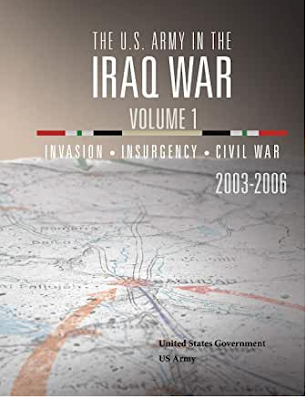At the end of 2003 the U.S. believed that it was winning in Iraq. It was underestimating the strength of the insurgency, thought the capture of Saddam Hussein was a turning point, and Washington sped up the timetable to return sovereignty to Iraq thinking that would be another blow to the militants. In fact, things were getting worse. The abuse at the Abu Ghraib prison occurred, the insurgency launched its first Ramadan offensive, and opposition to the occupation was only growing in strength.
The U.S. military was still having problems identifying the enemy it was facing. On October 28, 2003 Central Command head General John Abizaid briefed the Joint Chiefs of Staff estimating the insurgency at 4,000 former regime members, 2,000 Islamists from Ansar al-Islam and an unknown number of foreign fighters. An intelligence officer at the U.S. command in Iraq Colonel Derek Harvey thought those numbers were undercounts. One cause was the fact that the Americans were only registering around 1/3 of insurgent attacks. The U.S. didn’t have an integrated system to collect security incidents data and only counted attacks upon Americans and not ones on Iraqis. Finally on December 13 Saddam Hussein was captured which the U.S. believed was a major turning point. It was believed the former dictator was the leader and inspiration of most of the militants when he was not. From the start the U.S. military never understood what it was facing in Iraq. It initially thought it was fighting Baathists when there were so many more elements. That included militias and tribes.
The Bush administration announced a new timetable for returning sovereignty to Iraq but it was a sign that its political plans were not going right. In November 2003 the White House called Paul Bremer the head of the Coalition Provisional Authority (CPA) to D.C. for talks and told him they were scrapping his 2-3 year plan. Now Iraqis would regain control of their country in just seven months. The administration hoped the sped up timetable would reduce support for the insurgency. Bremer originally came up with his Iraq strategy without consulting with either Washington or Iraqis as Bremer wanted complete control over the entire process. That ended up angering everyone. The growing violence made D.C. believe that Bremer needed to be reined in. Handing over sovereignty to the Iraqis only ended up creating more problems in the country. It was also based upon the idea that if the U.S. gave more power to the Iraqis everything would solve itself. Again, the Americans would take months to realize how wrong they were.
During Ramadan several insurgent groups launched their first annual offensive. From October to November the Army of Mohammed, the National Islamic Resistance, Ansar al-Sunna and Abu Musab al-Zarqawi carried out their first campaign. That included the bombing of the Turkish embassy in Baghdad by Ansar al-Sunna and one day of attacks by Zarqawi in Karbala that killed 13 and wounded 170. Bremer claimed the campaign posed no strategic threat to the U.S. but showed how far the insurgency had advanced in just a few months. It would also point to the increasing violence in the country that would eventually lead to a civil war.
In the winter of 2003 the U.S. military units committed the Abu Ghraib prison scandal. By the fall of 2003 the U.S. held almost 10,000 prisoners. It didn’t have the personnel, facilities or training to handle them and there was confusion about the rules of how to treat them. Many were placed in the Abu Ghraib prison in Baghdad. The 519th Military Intelligence Battalion which came from Afghanistan took over interrogations at the prison in July 2003 and used many tactics that were violations of the Geneva Conventions. In August General Geoffrey Miller from Guantanamo Bay reviewed the questioning techniques at Abu Ghraib and made various suggestions on how to improve them. That led to more confusion amongst the soldiers about what to do. In October General Donald Ryder did a prison inspection in Iraq and warned that there could be serious human rights abuses. The scandal that later broke would tarnish the image of the Americans not only in Iraq but around the world. The U.S. also never resolved their problems with prisoners and its policies would end up helping the insurgency and militias.
The winter of 2003 saw continued failures in the U.S. occupation of Iraq. The U.S. didn’t understand the multi-faceted groups that were arrayed against it. It downplayed the first insurgent offensive. It scrapped its own political plan believing that doing less would allow it to leave the country. It committed gross human rights violations. The U.S. invaded Iraq with no plan for what would happen afterward. It failed to create a unified strategic plan. It therefore was doing things on an ad hoc basis like the new sovereignty plan and would continue to do so in 2004 digging itself further into a hole.
Chapter 1 Prologue The Collision Course 1991-2003
Chapter 3 Maneuvering Into Position
Chapter 4 The Invasion of Iraq
Chapter 5 We’re Here, Now What?
Chapter 6 Lost In Transition, May-July 2003
Chapter 7 Muqawama Wa Intiqaam (Resistance And Reprisals), May-August 2003
Chapter 8 Muddling Through August-October 2003
SOURCES
Rayburn, Colonel Joel, Sobchak, Colonel Frank Editors, with Godfroy, Lieutenant Colonel Jeanne, Morton, Colonel Matthew, Powell, Colonel James, Zais, Lieutenant Colonel Matthew, The U.S. Army In The Iraq War: Volume I, Invasion, Insurgency, Civil War, 2003-2006, Strategic Studies Institute and U.S. Army War College Press, 2019





No comments:
Post a Comment